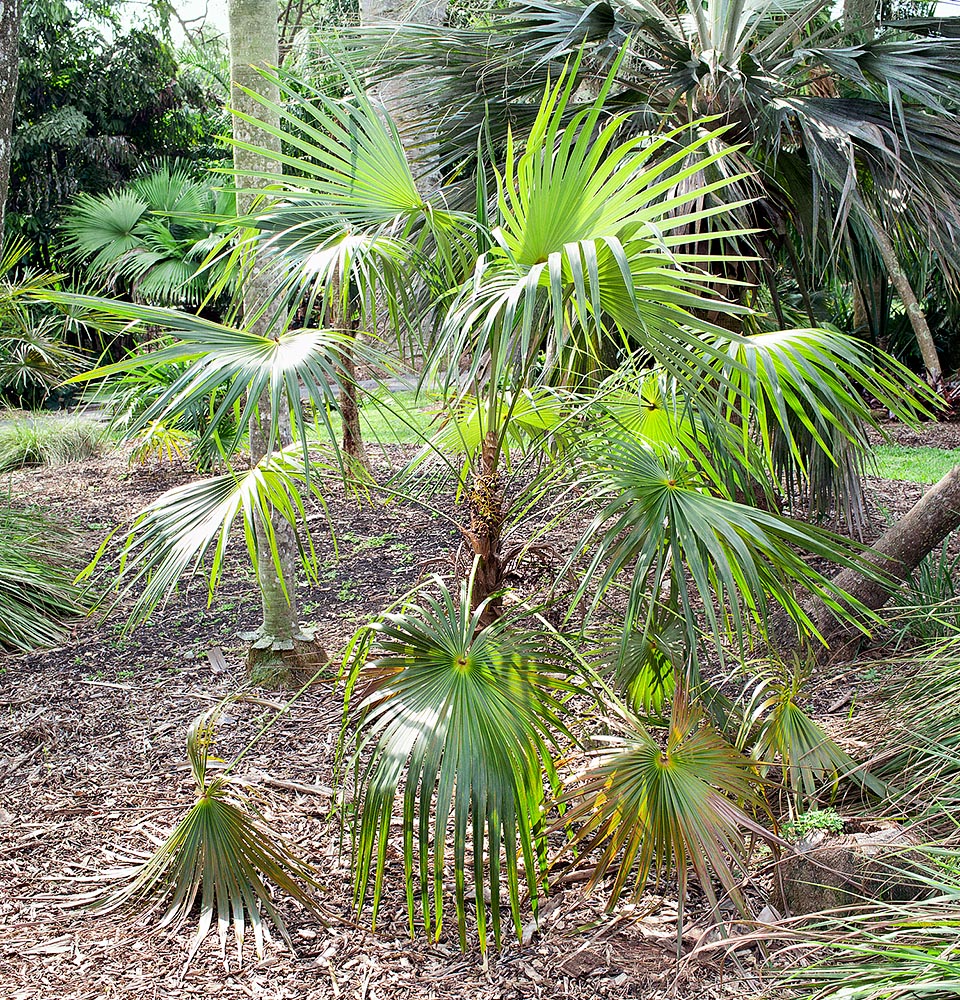Family : Arecaceae

Text © Pietro Puccio

English translation by Mario Beltramini
The species is native to north-eastern Belize and to south-eastern Mexico (Quintana Roo and Yucatan) where it grows along the coasts, even in dense colonies, in the humid forests, on calcareous rocks covered by a thin layer of humus, as well as in open areas on the coastal dunes, from the sea level up to about 400 m of altitude.
The generic name comes from the combination of the Greek term “κόκκος” (coccos) = berry and of the name of the genus Thrinax, to which these plants resemble; the species is honoured to the American botanist Robert William Read (1931-2003) who dedicated his professional life mainly to the study of the palms, the bromeliads and the orchids.
Common names: Mexican silver palm (English); knacás, náajk’aax, palmera plateada (Mexico).
The Coccothrinax readii Quero (1980) is an unarmed monoecious species with single stem, 1-4 m tall and of 3-5,5 cm of diameter, of greyish brown colour. The leaves, on a 25-110 cm long and 0,6-1,1 cm broad petiole, are palmate, orbicular, of 40-110 cm of diameter, dark green above, silver grey below, deeply incised in 39-54 linear-triangular segments with acuminate bifid apex, 40-70 cm long at the centre and merged at the base for a length of 13-30 cm. The foliar base is provided on the margins of thin fibres arranged in two layers wrapping the stem except in the oldest part; the hastula (appendage placed in the point of junction of the foliar blade with the petiole) is triangular with usually deeply bifid apex.

In northeastern Belize and south-eastern Mexico, Coccothrinax readii can be 4 m tall with a 3-5,5 cm stem. Easy to cultivate in tropical and subtropical gardens © G. Mazza
Inflorescences between the leaves (interfoliar), 40-80 cm long, initially erect, then curved when in fruit, ramified with 4-7spaced primary ramifications and of decreasing length towards the apex, the lowest one 10-25 cm long with 6-25 4,5-11 cm long rachillae. Hermaphroditic flowers, on a 0,2-0,4 cm long pedicel; of cream wihite colour, fragrant, with 8-13 stamina. The fruits are globose, of 0,5-1,3 cm of diameter, blackish purple when ripe, containing only one cerebriform seed of 0,3-1 cm of diameter. It reproduces by seed in draining loam maintained humid at the temperature of 26-28 °C, with germination times starting from 4 months.
Very variable species, depending on the microclimatic characteristics and on the soil, strictly related to the Coccothrinax argentata(Jacq.) L.H.Bailey (1939) and Coccothrinax jamaicensis Read. (1966), is cultivable in the tropical, subtropical climate zones and, marginally warm temperate, where it can resist, adult, to occasional decreases of temperature close to 0 °C for a short period. In nature it grows in full sun as well as in partial shade and in areas with high humidity, but well rooted it can stand drought periods, even if takes advantage from regular waterings in the zones characterized by seasonal climates with long warm and dry summers. It is not particular about the soil, even if poor, provided perfectly draining, with preference for the calcareous rocky and sandy ones. It bears the salty winds, hence it can be utilized in gardens close to the sea.
The stems are utilized in the rural constructions and for realizing fences and the leaves for realizing mats, lobster traps, bags and othe common use handicrafts.
→ For general notions about ARECACEAE please click here.
